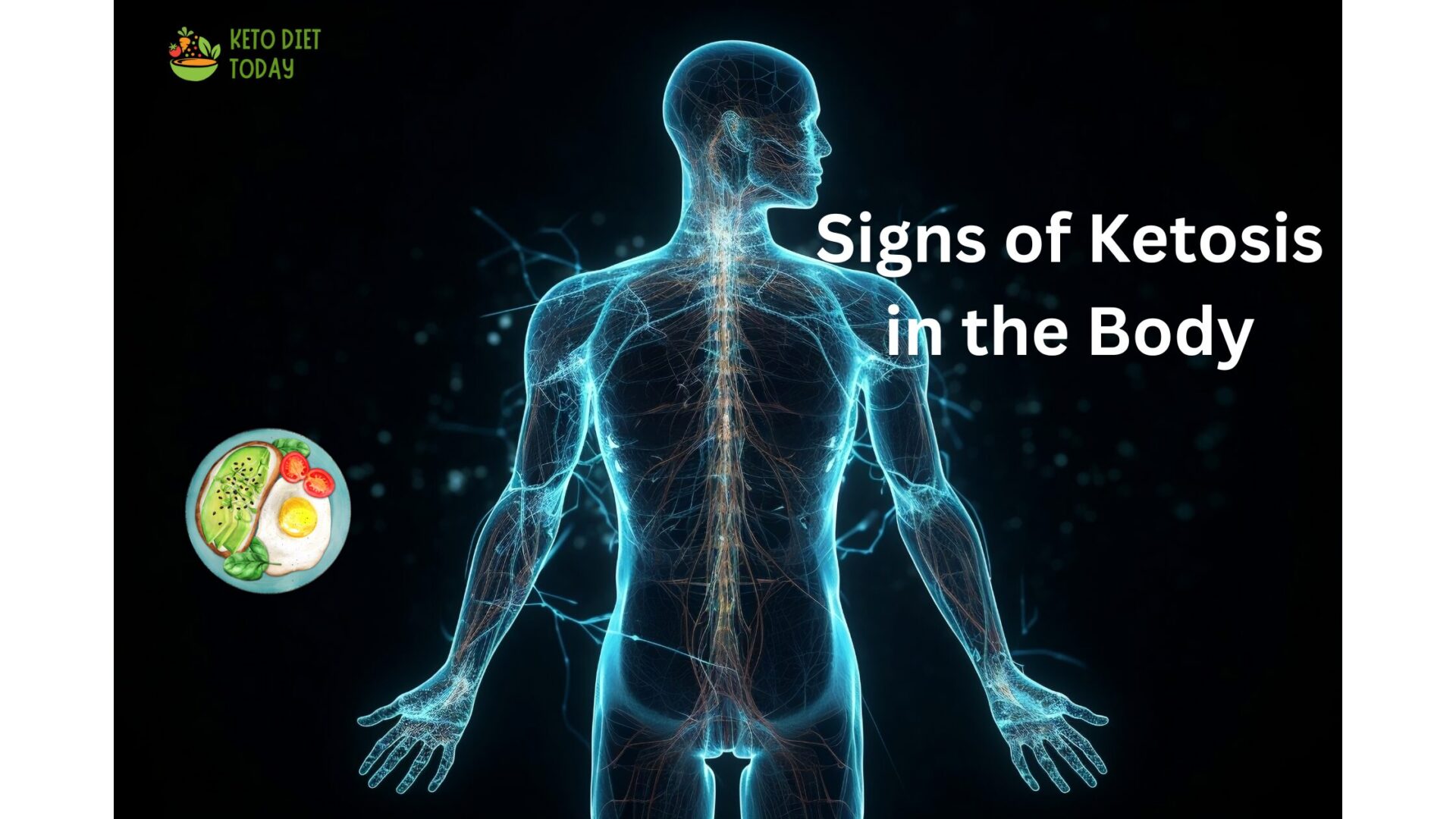Signs of Ketosis in the Body: A Comprehensive Guide

The ketogenic diet has surged in popularity due to its potential for weight loss, enhanced energy, and improved cognitive function. However, one of the most common questions keto beginners ask is, “How do I know if I’m in ketosis?” Recognizing the signs of ketosis in the body is crucial for determining whether your body has successfully transitioned into fat-burning mode. Ketosis happens when the body shifts from using glucose (carbohydrates) for energy to using ketones (fat) as its primary fuel source.
In this comprehensive guide, we’ll dive into the physical, mental, and measurable signs of ketosis. We’ll also explain how to confirm ketosis through testing, the timeline for entering ketosis, and tips to stay in this fat-burning state. By the end of this post, you’ll be well-equipped to recognize when your body has entered ketosis and how to maintain it for optimal results.
What Is Ketosis? Understanding the Metabolic State
Before we discuss the specific signs of ketosis, it’s essential to understand what ketosis is and how it works. Ketosis is a natural metabolic state in which your body burns fat for fuel instead of carbohydrates. When you significantly reduce your carbohydrate intake, your body’s glycogen stores (stored glucose) are depleted. As a result, the liver starts converting fat into molecules called ketones, which are then used by the brain and body for energy.
This metabolic shift is the foundation of the ketogenic diet, and achieving ketosis is key to reaping the diet’s many benefits. Entering and staying in ketosis enables your body to efficiently burn stored fat, leading to weight loss, improved mental clarity, and sustained energy levels throughout the day.
How Long Does It Take to Enter Ketosis?
The time it takes to enter ketosis varies from person to person, typically ranging from 2 to 7 days. Several factors influence how quickly you’ll reach ketosis, including your carbohydrate intake, physical activity, metabolism, and fasting practices.
If you want to speed up the process, there are ways to accelerate your entry into ketosis. Limiting carbs to fewer than 20 grams per day, incorporating intermittent fasting, and exercising to deplete glycogen stores can help you enter ketosis faster.
For more information on how to get into ketosis quickly, check out Ruled.me’s guide to entering ketosis fast.
Signs of Ketosis in the Body: What to Look For
Once you’ve started a ketogenic diet and reduced your carb intake, you’ll likely begin to notice various physical and mental signs indicating that your body has entered ketosis. These signs can vary in intensity, and some may only last for a few days as your body adapts to its new fuel source.
1. Increased Urination
One of the earliest signs of ketosis is increased urination. As your body depletes glycogen stores, it releases water stored in your muscles. This leads to frequent trips to the bathroom. Additionally, ketones (specifically acetone) are excreted through urine, further increasing the need to urinate.
2. Dry Mouth and Increased Thirst
As your body flushes out water, you may experience dry mouth or increased thirst. This is often due to electrolyte imbalances caused by the rapid loss of sodium, potassium, and magnesium during the early stages of ketosis. Staying hydrated and replenishing electrolytes can help alleviate these symptoms.
Tip: Drink plenty of water and consider adding an electrolyte supplement or Himalayan pink salt to your diet to restore lost minerals.
3. Bad Breath (Keto Breath)
Keto breath is a common sign of ketosis and is caused by the production of acetone, one of the ketones produced during fat metabolism. Acetone has a distinct fruity or metallic smell and is often exhaled through the breath, leading to temporary bad breath. While keto breath can be unpleasant, it’s a good indication that your body is in ketosis.
Tip: Chewing sugar-free gum or drinking more water can help reduce the intensity of keto breath.
4. Decreased Appetite
One of the more surprising signs of ketosis is a decreased appetite. Many people on the keto diet report feeling less hungry throughout the day. This is partly because fat and protein are more satiating than carbohydrates, but ketones themselves also have an appetite-suppressing effect. As your body becomes more efficient at burning fat for energy, you may find that you need to eat less frequently.
5. Increased Energy and Mental Clarity
After an initial adjustment period, many people experience a noticeable increase in energy levels and mental clarity once they’ve entered ketosis. This is because ketones are a more stable and efficient fuel source than glucose, which leads to fewer energy crashes and more sustained cognitive function. If you’ve been feeling more focused and alert, it’s a strong sign that your body is utilizing ketones for energy.
6. Short-Term Fatigue (Keto Flu)
During the first few days of transitioning into ketosis, you may experience a temporary dip in energy levels known as the keto flu. Symptoms of the keto flu include headaches, fatigue, irritability, and nausea. This occurs as your body adjusts to burning fat instead of carbs and can last for a few days.
Tip: Staying hydrated, replenishing electrolytes, and eating enough fat can help alleviate the symptoms of keto flu. For more advice on avoiding keto flu, check out Healthline’s guide on keto flu.
7. Digestive Changes
It’s common to experience digestive changes when starting the ketogenic diet. You may notice a change in bowel movements, such as constipation or diarrhea, as your body adapts to the high-fat content of the diet. These digestive issues are usually temporary and can be managed by increasing your fiber intake from low-carb vegetables and staying hydrated.
Measuring Ketosis: How to Confirm You’re in Ketosis
While the physical and mental signs mentioned above are good indicators that you’re in ketosis, the most accurate way to confirm ketosis is through testing. There are three primary methods for measuring ketone levels in the body: urine, blood, and breath testing.
1. Ketone Urine Strips
Urine strips are an inexpensive and convenient way to measure ketone levels. These strips detect the presence of acetoacetate, a type of ketone body, in your urine. As your body produces ketones, the strip will change color, indicating the concentration of ketones. While urine strips are a good option for beginners, they may become less accurate as your body becomes more efficient at using ketones.
2. Blood Ketone Meters
A blood ketone meter is the most accurate way to measure ketosis. It works similarly to a blood glucose meter, where you prick your finger and place a drop of blood on a test strip. The meter then reads the concentration of beta-hydroxybutyrate (BHB), the main ketone body in your blood. Blood ketone levels between 0.5 and 3.0 mmol/L indicate that you’re in ketosis.
3. Breath Ketone Analyzers
Breath ketone analyzers measure the concentration of acetone in your breath. Acetone is a byproduct of ketosis and can be detected when you exhale. While not as precise as blood meters, breath analyzers are convenient because they don’t require disposable test strips.
How to Maintain Ketosis: Tips for Staying in Fat-Burning Mode
Now that you’ve entered ketosis, the goal is to stay in this fat-burning state to maximize the benefits. Here are some tips for maintaining ketosis:
1. Monitor Your Carb Intake
The key to staying in ketosis is to keep your carbohydrate intake low. Aim to consume less than 20-50 grams of net carbs per day, depending on your individual tolerance. Stick to low-carb vegetables, healthy fats, and moderate protein to maintain ketosis.
2. Prioritize Healthy Fats
Eating enough fat is crucial for staying in ketosis. Make sure that 70-75% of your daily calories come from healthy fats like avocados, olive oil, coconut oil, and fatty cuts of meat. This will ensure that your body continues to use fat as its primary fuel source.
3. Incorporate Fasting
Intermittent fasting is a powerful tool for maintaining ketosis. Fasting periods allow your body to burn through glycogen stores and continue producing ketones. The most common fasting method is the 16:8 schedule, where you fast for 16 hours and eat within an 8-hour window.
4. Stay Hydrated and Replenish Electrolytes
Maintaining proper hydration and electrolyte balance is crucial for preventing symptoms like fatigue and muscle cramps while in ketosis. Drink plenty of water and consider adding electrolyte supplements or salt to your meals.
Conclusion: Recognizing the Signs of Ketosis in the Body
Understanding the signs of ketosis in the body is key to tracking your progress on the ketogenic diet. From increased energy and mental clarity to physical changes like dry mouth and bad breath, these indicators can help you confirm that your body has successfully transitioned into fat-burning mode. Testing your ketone levels with urine, blood, or breath tests offers a more accurate measure of ketosis.
By monitoring these signs, staying consistent with your carb intake, and incorporating the tips for maintaining ketosis, you’ll be well on your way to achieving your health and weight loss goals on the ketogenic diet.
For more tips on staying in ketosis, visit Ruled.me’s guide to maintaining ketosis.








